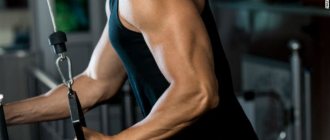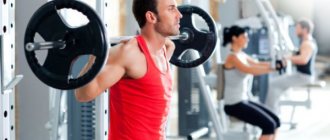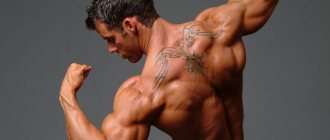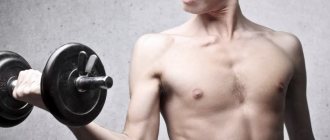How long does it take to recover after training?
On average, recovery takes 72 hours. Accordingly, training in the gym more than 2-3 times a week does not make sense. It is worth considering that time directly depends on muscle volume. Strength training is characterized by muscle microtrauma, so rehabilitation after it takes more time.
The main recovery phases during the post-workout period:
- Fast . Occurs in the first half hour after class. The body especially needs minerals and glucose during this period.
- Slow motion. Having eliminated the imbalance of nutrients and minerals, the process of restoration of cells and tissues that have received microtrauma begins. At this stage, protein synthesis is activated, so it must be supplied with food in the right quantity.
- Supercompensation. The most important recovery phase occurs on the 3rd day after training. It will be most powerful after exhausting training with heavy weights. The next lesson is attended during this phase.
- Deferred . The phase begins if the body has not received the necessary load. If you miss even one training session, the recovery process slows down significantly. Therefore, it is important not to deviate from your study schedule. Otherwise, during this period the body returns to the state it was before training.
Rehabilitation goals
A rehabilitation course after operations and injuries allows you to achieve the following results:
- regenerate muscle tissue, restore the previous level of strength and tone;
- restore motor activity of joints impaired after injuries, fractures, surgical interventions, immobilization;
- improve tissue regeneration, incl. cartilaginous;
- increase mobility with adhesions and scars;
- improve the trophism of muscle and bone tissues of the body;
- eliminate swelling and pain;
- improve blood circulation in damaged joints or limbs.
In addition, rehabilitation helps strengthen the patient’s overall tone and improve his emotional and psychological state. The absence of a timely rehabilitation course can lead to complications, re-development of the disease and threatens incomplete restoration of muscle strength.
Basic recovery methods
Answering the question of how to recover after training in the gym, it is worth noting that the process can be active or passive.
- Passive. Recommended rest from stress. Abstinence should be at least 2-3 days. This method is suitable for everyone, especially if there are signs of overtraining. The method is not recommended for frequent use, as it complicates adaptation to new loads. As a result, there is no progress.
- Active. It consists of a set of active measures: cardio training after exercise for 10 minutes, stretching and massage.
In both cases, proper nutrition plays an important role. After exercise, the body must replenish the level of consumed carbohydrates and proteins. This will compensate for their loss. After training, it is recommended to drink whey protein to support muscles.
How to understand that the body is recovering correctly?
- If two hours after exercise your pulse exceeds 75 beats, your blood pressure is high - you have overtrained.
- Sound sleep and a feeling of vigor are sure signs of the right path. Feeling exhausted, lethargic in the first half of the day, poor sleep and insomnia are a sign of overtraining.
- Visible results are also a good sign. If there is no progress, the body does not have time to recover.
- Pay attention to the general condition - pain in the heart, decreased performance, lethargy and weakness indicate overtraining.
Recommendations for quick recovery after training in the gym
To get the maximum results from training in the gym, you need to pay close attention to recovery after training. By adhering to these 8 principles, you can quickly achieve your goal.
- Reasonable loads. There must be moderation in everything. Loads should stimulate muscle growth, and not destroy them, causing pain for several days. The priority should not be the speed of recovery, but its productivity and quality. Train to do more repetitions than the previous workout. With this regime, constant and lasting progress will be observed.
- Nutrition before training. Absorption is a long process, so nutrition before going to the gym plays an important role. Choose your foods wisely. They should contain high-quality protein and complex carbohydrates if you plan on intense exercise. The last meal should be no later than 2 hours before the training.
- Don't ignore stretching. Stretching is responsible for the growth of muscle mass. Stretching is a great way to reduce muscle tension and relieve pain during the recovery process. It needs to be given at least a quarter of an hour after training.
- Protein after workout. The body needs a portion of protein after physical activity. It should range from 20 to 50 grams, depending on the weight and gender of the athlete. Whey protein is the most popular protein supplement. To speed up recovery, it is enough to take 30 g of protein with fast carbohydrates after training. This could be fruit or juice. They will increase the level of glycogen and insulin - a powerful anabolic that stimulates the restoration of muscle proteins and glycogen.
- Massage. Muscles need massage before and after exercise. This significantly affects the quality of training and the recovery process. Before exercising, a massage will warm up your muscles. Afterwards, relax them.
- Quality sleep. Disruption of sleep patterns stimulates an increase in the level of catabolic hormones and a decrease in anabolic hormones, which as a result causes a deterioration in protein synthesis and a slowdown in the recovery process.
- Light cardio workout after training in the gym. After completing the strength training, you should definitely pay attention to quiet cardio training. Its duration is individual for each athlete. To do this, you need to find out the heart rate norms specifically for you. At the end of the workout, you need to measure your blood pressure and pulse. For every 10 beats above normal, you need to do 2 minutes of quiet cardio. That is, if your heart rate after training is 135 beats per minute, when the norm is 65, then you need to devote at least 14 minutes to training.
- Including potassium-rich foods in your diet. At the end of an intense workout, the body will experience a potassium deficiency. Along with other nutrients, it is one of the main minerals in the formation of muscle energy. Potassium sources include potatoes and bananas.
After training, we go to the shower and continue to follow the above recommendations for active recovery. After 2-3 days, you can return to the gym to continue training.
What foods restore muscles?
The following products will help reduce pain and speed up the recovery process:
- Eggs contain protein and carbohydrates, are low in calories, and will help build muscle mass and restore energy.
- Orange juice will quickly replenish energy due to its vitamin C and potassium content.
- Bananas contain many healthy carbohydrates and will help replenish energy reserves.
- Kefir contains whey protein, which helps burn fat.
- Salmon is a source of healthy omega-3 fats that relieve pain and inflammation.
- Nuts contain omega-6, have a positive effect on tissue healing, and relieve fatigue.
- Cinnamon, turmeric, ginger will speed up muscle recovery, replenish energy reserves, and reduce pain.
Problems of modern stretching research
One of the main problems that applies to almost all stretching studies is the ability to correctly determine the intensity of stretching: how to measure the intensity of stretching? For example, how do you calculate or determine that stretching is slightly uncomfortable, moderately uncomfortable, or very uncomfortable in an experiment given the different pain tolerances of people. The situation is further complicated by the specificity of pain in relation to exercise, meaning that some people may tolerate greater strain with certain exercises compared to others (12). This also further complicates comparative studies—athletes may have a higher pain tolerance with quadriceps strains than with hamstring strains. Athletes are often encouraged to stretch without pain, but the line between pain and discomfort is unclear (6). Moreover, to our knowledge, no single measure has been proposed to reliably measure the level, intensity, or magnitude of stretching. In general, there are many problems with the reliability of stretch studies, making comparisons between similar studies very difficult.
FAQ
When can you sit down after surgery?
Not until the spine is strong enough. If there are no problems, you can sit 4 weeks after the hernia surgery.
Are there relapses during the rehabilitation period?
They happen, but proper rehabilitation will reduce the risk of hernia recurrence.
How to eliminate leg pain during rehabilitation?
Leg pain after hernia removal is normal. The reason is the long-term pressure of the hernia on the nerves through which the brain controls the functioning of the legs. During surgery, the pressure is relieved, but it may take several weeks for the nerve tissue to recover. During this time, your lower leg will hurt, your hip will pull, and your limbs will experience numbness. If, while recovering, your leg suddenly begins to hurt sharply and go numb, be sure to tell your doctor. The sooner he determines the cause of the complication, the faster the chances of a speedy recovery, and you will not have to spend several years on treatment.
When can I plan a pregnancy after finishing rehabilitation?
You cannot plan to conceive within a year after removal of the hernia. The fetus will put pressure on the spine, causing a relapse. If you become pregnant, contact your doctor right away.
Is disability granted after completion of rehabilitation?
Rarely, only if the patient’s mobility has not been restored. The decision on disability is made by the ITU commission after a comprehensive examination. The status is assigned for six months, after which it must be confirmed. Your doctor will tell you whether you can get disability.
When is sick leave closed during the rehabilitation period?
If rehabilitation is successful, there are no complications, the doctor closes sick leave after the end of rehabilitation - after 2-3 months. After this, the patient can return to work or change it if it involves difficult working conditions.
Bibliography
- Badalyan L. O. Neuropathology. - M.: Education, 1982. - 317 p.
- Bogolyubov, Medical rehabilitation (manual, in 3 volumes). // Moscow - Perm. - 1998. - 1885 p.
- Popov S. N. Physical rehabilitation. 2005. - 608 p.
- Feshchenko, Ya. V. Non-surgical treatment and prevention of recurrence of intervertebral disc herniations / Ya. V. Feshchenko, L. D. Kravchuk // Pain. Joints. Spine. ─ 2014. ─ No. 3(15). ─ P. 59-61.
Themes
Intervertebral hernia, Spine, Pain, Treatment without surgery Date of publication: 03/26/2021 Date of update: 03/28/2021
Reader rating
Rating: 5 / 5 (1)
Prospects for further research
In addition to the potential difficulties in studying stretching regarding its methods and effects on recovery, the following areas of research are recommended for future research:
- Head-to-head comparisons of stretching with other recovery techniques and their ability to increase ASD.
- An indicator for quantifying the intensity of stretching.
- Determining acceptable pain for various stretches (eg, quadriceps and hamstrings).
Causes of damage to the central nervous system
Complete loss of movements or their weakening are caused by paralysis and paresis. In such cases, there are several types of dysfunction of the muscles of the limbs:
- tetraplegia (impaired functioning of all limbs);
- monoplegia (impaired functioning of only one limb);
- paraplegia (impaired mobility of the upper or lower extremities);
- hemiplegia (lack of strength in the muscles of the limbs located on the left or right side of the body).
Among the main causes of disruption of the central nervous system, experts indicate:
- brain or spinal cord injuries (bruises, concussions, compression);
- stroke;
- injury or pathology of nerve trunks;
- severe poisoning of the body;
- tumor processes in the brain or its membranes;
- metabolic disorder;
- infections affecting nerve cells;
- severe and frequent stress.
Regardless of whether motor activity has been partially or completely impaired, movements of the upper extremities are much more difficult to fully restore than those of the lower extremities, because fine motor skills are very important for the hands.











